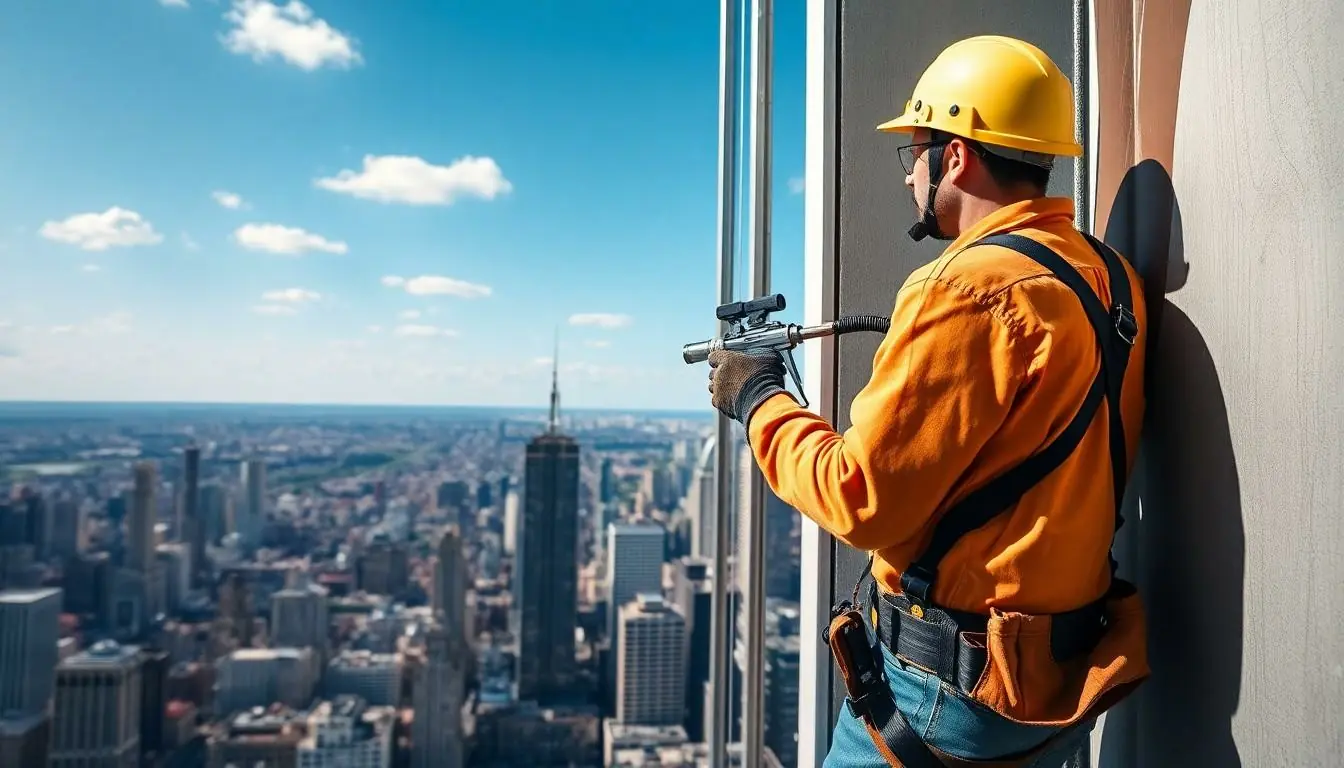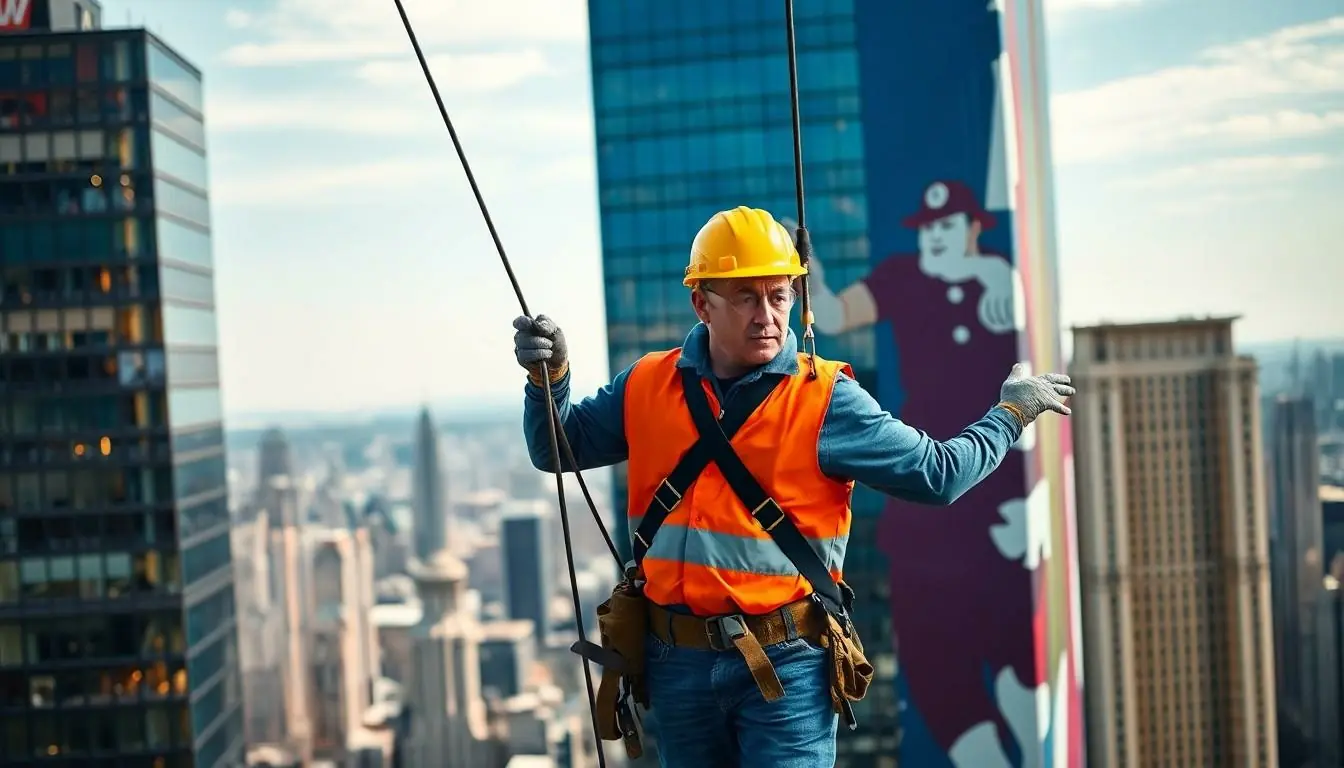Table of Contents
ToggleHigh rise painting isn’t just a job; it’s an adrenaline-pumping adventure that’ll make you feel like a superhero—minus the spandex. Imagine scaling the sides of skyscrapers, armed with nothing but a paintbrush and a safety harness, transforming dull concrete into vibrant masterpieces. It’s not just about aesthetics; it’s about breathing new life into towering structures that define city skylines.
Overview of High Rise Painting
High rise painting involves specialized techniques for painting tall buildings, requiring extensive training and safety measures. Painters engage in this work to enhance urban aesthetics and protect structures from harsh weather. Innovations in equipment, such as aerial lifts and harness systems, bolster safety and efficiency during projects.
Safety regulations govern high rise painting, necessitating compliance with OSHA standards and guidelines. A skilled team often performs risk assessments before embarking on a project to identify potential hazards. Permission from building owners and local authorities typically precedes any painting work to ensure all legal requirements are met.
Weather conditions play a crucial role in scheduling high rise painting tasks. Wind and rain can hinder progress and pose risks, so teams monitor forecasts closely. Additionally, the choice of paint is essential; it must withstand elements like UV rays and moisture while adhering to surface materials.
High rise painting not only revives the appearance of a building but also serves functional purposes. Protective coatings safeguard facades from decay and corrosion, extending the lifespan of structures. Color selection impacts not only aesthetics but also energy efficiency, with lighter tones reflecting heat.
Experience in the field can contribute to a painter’s expertise in navigating difficult conditions. Some painters undergo certification programs to hone their skills and refine safety protocols. Continuous education ensures teams stay updated on best practices and new materials.
Creativity plays an integral role, as painters often collaborate with architects and designers. This collaboration helps translate artistic visions into reality, whether through detailed murals or simple color schemes. Transforming city skylines remains the ultimate goal of high rise painting, allowing urban landscapes to flourish.
Techniques Used in High Rise Painting

High rise painting employs various techniques to ensure both aesthetic appeal and longevity. Painters utilize two main types of methods: conventional and advanced technology.
Conventional Painting Methods
Brush and roller techniques maintain their popularity among high rise painters. These traditional methods allow for precise application, especially on less accessible surfaces. Airless spray painting offers quick coverage, making it ideal for large areas on skyscrapers. Scaffolding or swing stage systems often assist painters in reaching elevated spots, ensuring safety and efficiency. Painters prioritize surface preparation, which includes cleaning and priming surfaces to enhance paint adhesion. While these methods require skill and safety training, they remain a foundational approach for many high rise projects.
Advanced Technology in High Rise Painting
New technology revolutionizes high rise painting strategies. Drones equipped with spray technology enhance accessibility, reducing the need for scaffolding. Robotics bring precision to painting tasks, minimizing human error and increasing consistency. Smart coatings offer additional benefits by responding to environmental changes, thus extending the lifespan of paint. Painters also leverage digital tools for project planning and scheduling, optimizing workflow and minimizing downtime. These advancements support safety initiatives and help in elevating the overall quality of the painting process.
Safety Measures in High Rise Painting
High rise painting involves various safety measures to protect workers during operations. Adhering to these protocols ensures both efficiency and safety on the job site.
Personal Protective Equipment (PPE)
PPE is crucial for painters working at heights. Hard hats provide head protection from falling objects. High-visibility vests enhance visibility in outdoor environments. Safety harnesses are essential for preventing falls during ascents and descents. Additionally, gloves protect hands from chemicals, while respirators safeguard against harmful fumes. Eye protection helps prevent injury from splashes and debris. Commitment to using adequate PPE significantly reduces risks associated with high rise painting.
Safety Regulations and Standards
Compliance with safety regulations is mandatory in high rise painting. Regulations outlined by OSHA provide guidelines for fall protection, scaffolding, and personal safety. Adhering to these standards minimizes accidents and injuries. Training programs ensure workers understand equipment usage, emergency protocols, and hazard recognition. Furthermore, regular safety audits identify potential hazards and provide corrective actions. A strong safety culture cultivates awareness, enhancing overall performance and wellbeing in high rise painting projects.
Challenges in High Rise Painting
High rise painting presents a variety of unique challenges that require specialized skills and extensive planning.
Weather Conditions
Weather conditions can significantly influence high rise painting projects. Rain, snow, and high winds pose substantial risks for workers at elevated heights. Extreme temperatures can affect paint application and drying times, leading to compromised results. Scheduling becomes critical due to these factors; painters often need to monitor forecasts closely. Unpredictable weather may lead to project delays, impacting timelines and budgets. Additionally, appropriate paint selection is vital for withstanding these environmental challenges. Durable coatings designed for extreme conditions ensure longevity and performance.
Accessibility Issues
Accessibility issues frequently complicate high rise painting tasks. Limited space around buildings can obstruct equipment and material transport. Narrow streets or surrounding buildings often restrict lift and scaffolding placement. Workers must utilize specialized techniques, such as harnesses and ropes, to navigate difficult access points safely. High vantage points require reliable scaffolding or aerial platforms to ensure safe operations. Painters often engage in extensive planning to preemptively address these challenges, maximizing both safety and efficiency. Each project demands a tailored approach to accessibility for successful execution.
High rise painting is more than just a job; it’s a vital part of urban transformation. The combination of artistry and technical skill allows painters to breathe new life into cityscapes while ensuring safety and compliance with industry standards. As they navigate the challenges of height and weather, these professionals play a crucial role in enhancing both the aesthetic and functional aspects of buildings.
With advancements in technology and a commitment to continuous learning, high rise painters are equipped to tackle any project. Their work not only beautifies the skyline but also contributes to the longevity and efficiency of structures. The dedication and expertise of these individuals ensure that urban environments remain vibrant and resilient for years to come.




